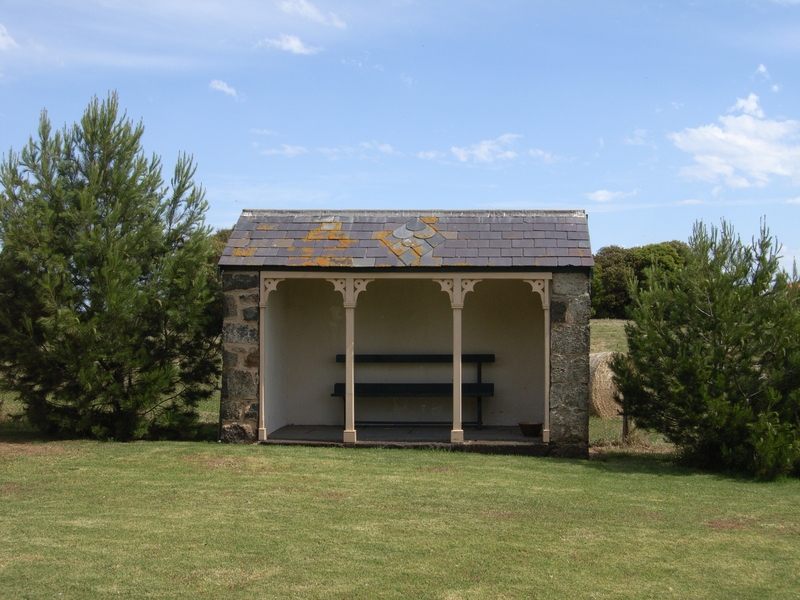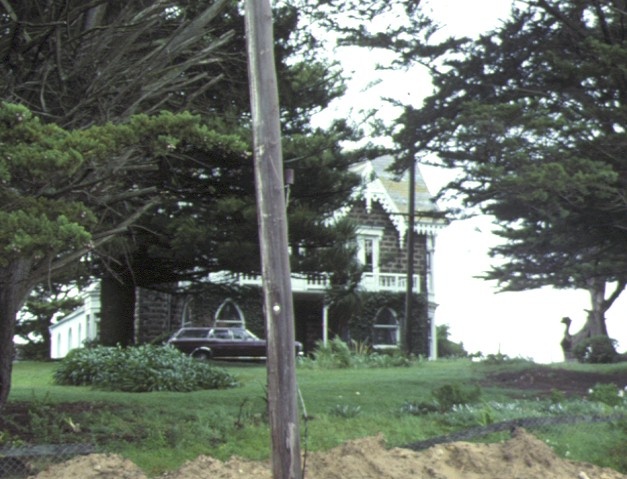TALARA
543-555 PRINCES HIGHWAY PORT FAIRY, MOYNE SHIRE
-
Add to tour
You must log in to do that.
-
Share
-
Shortlist place
You must log in to do that.
- Download report






Statement of Significance
What is significant?
Talara is located on a rise beside the road to Portland a short distance outside Port Fairy and, with its setting and views, can be described as a villa. The first section, a single-storey, two-room, bluestone 'cottage' later used as a kitchen wing, appears to have been built in 1856. The owner was Dilmond John Howes, the first Secretary and Engineer to the Shire of Belfast. It is very likely that he designed and built the main two-storey, bluestone house of ten principle rooms and offices. The picturesque Gothic revival style, combined with the villa form, is rare in Victoria but characteristic of the use of architectural pattern books, particularly mid-nineteenth-century American editions. The porch with its pair of Gothic 'pavilions' is most unusual. The internal lobby and hall with their wood grained joinery are notable, as is the Gothic stair balustrade. The symmetrically disposed side bay windows are more classical in their detailing and have different glazing, the eastern bay's blind glazing and ventilator being of special interest. The rendered stone building, which was added in 1886 as a new kitchen and pantry, has semicircular arched windows. Andrew Vernon Suter owned Talara from 1878 and, in 1894; he sold to Joseph Powell whose family remained in ownership until 1945. Mrs Dunbar was a major owner subsequently. The house retains a high degree of integrity and is in excellent condition.
How is it significant?
Talara is of aesthetic, architectural and historical significance to the State of Victoria.
Why is it significant?
Talara is significant as one of the few examples of a Gothic revival villa in Victoria and for its use of the Picturesque aesthetic developed in and promoted by architectural pattern books during the nineteenth century. It is all the more important for its elaboration and the integrity of its setting. Its designer and first owner D. J. Howes is of historical significance as the longest serving municipal engineer in the colony, notwithstanding the turbulence of his period of office. Furthermore, his first wife was the sister and his second wife was the daughter of Howes' friend, the pioneering physician and philanthropist, Dr John Singleton.
[Online Data Upgrade Project 2001]
-
-
TALARA - History
REGISTER OF THE NATIONAL ESTATE - CITATION: THE TWO STOREY STONE HOUSE
'TALARA' ON THE YAMBUK ROAD, WEST OF PORT FAIRY, WAS APPARENTLY BUILT FOR
DILMOND JOHN HOWES, THE FIRST SECRETARY AND SURVEYOR TO THE BELFAST AND
DISTRICT ROADS BOARD, AND IS AN ADDITION TO AN EARLIER COLONIAL GEORGIAN
STYLE STONE COTTAGE OF C.1845 THE DESIGN, WHICH COMBINES A VARIED ARRAY OF
STYLISTIC MOTIFS INTO AN AXIAL PICTURESQUE COMPOSITION, WAS CONSTRUCTED BY AN
UNKNOWN BUILDER IN THE MID 1850'S. THE HISTORY OF TALARA REMAINS VIRTUALLY
UNDOCUMENTED. THIS UNUSUAL BUILDING IS ONE OF THE MOST ECLECTIC, EVOCATIVE
AND PICTURESQUE ARCHITECTURAL COMPOSITIONS OF THE 1850'S IN VICTORIA, AND ONE
WHICH IS CLEARLY DERIVED FROM PATTERN BOOK SOURCES. IT IS POSSIBLY THE WORK
OF D.J. HOWES, AN ENGINEER/SURVEYOR AND CENTRAL FIGURE IN THE HISTORY OF
LOCAL GOVERNMENT IN THE SHIRE OF BELFAST IN THE MID-NINETEENTH CENTURY
TALARA AT PORT FAIRY IS WELL PRESERVED AND IN EXCELLENT AND NEAR ORIGINAL
CONDITION. THE INTERIOR IS OF SPECIAL NOTE. OF STATE SIGNIFICANCE
TALARA - Permit Exemptions
General Exemptions:General exemptions apply to all places and objects included in the Victorian Heritage Register (VHR). General exemptions have been designed to allow everyday activities, maintenance and changes to your property, which don’t harm its cultural heritage significance, to proceed without the need to obtain approvals under the Heritage Act 2017.Places of worship: In some circumstances, you can alter a place of worship to accommodate religious practices without a permit, but you must notify the Executive Director of Heritage Victoria before you start the works or activities at least 20 business days before the works or activities are to commence.Subdivision/consolidation: Permit exemptions exist for some subdivisions and consolidations. If the subdivision or consolidation is in accordance with a planning permit granted under Part 4 of the Planning and Environment Act 1987 and the application for the planning permit was referred to the Executive Director of Heritage Victoria as a determining referral authority, a permit is not required.Specific exemptions may also apply to your registered place or object. If applicable, these are listed below. Specific exemptions are tailored to the conservation and management needs of an individual registered place or object and set out works and activities that are exempt from the requirements of a permit. Specific exemptions prevail if they conflict with general exemptions. Find out more about heritage permit exemptions here.Specific Exemptions:General Conditions: 1. All exempted alterations are to be planned and carried out in a manner which prevents damage to the fabric of the registered place or object. General Conditions: 2. Should it become apparent during further inspection or the carrying out of works that original or previously hidden or inaccessible details of the place or object are revealed which relate to the significance of the place or object, then the exemption covering such works shall cease and Heritage Victoria shall be notified as soon as possible. Note: All archaeological places have the potential to contain significant sub-surface artefacts and other remains. In most cases it will be necessary to obtain approval from the Executive Director, Heritage Victoria before the undertaking any works that have a significant sub-surface component. General Conditions: 3. If there is a conservation policy and planall works shall be in accordance with it. Note:A Conservation Management Plan or a Heritage Action Plan provides guidance for the management of the heritage values associated with the site. It may not be necessary to obtain a heritage permit for certain works specified in the management plan. General Conditions: 4. Nothing in this determination prevents the Executive Director from amending or rescinding all or any of the permit exemptions. General Conditions: 5. Nothing in this determination exempts owners or their agents from the responsibility to seek relevant planning or building permits from the responsible authorities where applicable. Minor Works : Note: Any Minor Works that in the opinion of the Executive Director will not adversely affect the heritage significance of the place may be exempt from the permit requirements of the Heritage Act. A person proposing to undertake minor works must submit a proposal to the Executive Director. If the Executive Director is satisfied that the proposed works will not adversely affect the heritage values of the site, the applicant may be exempted from the requirement to obtain a heritage permit. If an applicant is uncertain whether a heritage permit is required, it is recommended that the permits co-ordinator be contacted.TALARA - Permit Exemption Policy
-
-
-
-
-
FORMER ST ANDREWS PRESBYTERIAN CHURCH AND MANSE
 Victorian Heritage Register H0850
Victorian Heritage Register H0850 -
THISTLE PLACE LIME KILN SITE
 Victorian Heritage Inventory
Victorian Heritage Inventory -
State School 1188
 National Trust
National Trust
-
Archaeological site
 Southern Grampians Shire
Southern Grampians Shire -
Avoca
 Stonnington City H0809
Stonnington City H0809 -
BANYULE
 Victorian Heritage Register H0926
Victorian Heritage Register H0926
-
-










